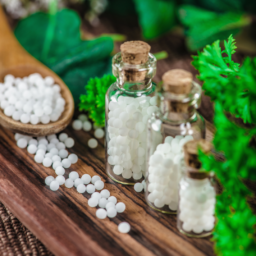Have you heard of homeopathy?

I first learned about homeopathy 30 years ago when I was struggling with a chronic autoimmune issue affecting my bladder. When I shared my concern with a Pilates instructor she asked, “Have you heard of homeopathy?” That turned out to be a life-altering question.
Homeopathy proved to be more helpful than I could have ever imagined. Not only did my chronic issue resolve, but all my allergies improved for good, and over time, I was able to rewire and strengthen my immune system in ways I never thought possible.
Those little unassuming white pills, although gentle, safe and natural, incapsulate surprising power to bring the body into balance. Homeopathy assists with all manner of acute illness quite handily and can also support healing of chronic, deep-rooted conditions. Because it’s a type of energy medicine, it is able to support the whole person—mind, body and spirit—and activate the innate healing ability of the individual.
If you’ve never heard of homeopathy or if you’re quite familiar, I hope this article will empower you and spur your curiosity to learn more.
What is Homeopathy?
Homeopathy is a frequency-based, holistic system of medicine that works quickly and gently, is non-toxic, and safe for infants, pregnant women, and elderly individuals. It was discovered in Germany over 200 years ago by Dr. Samuel Hahnemann, M.D. who was a brilliant, forward-thinking physician.
While translating a medical textbook, he was led to explore the idea of using medicinal substances to treat the specific symptoms of diseases that those same substances in their crude form would cause if given to a healthy person. He first made this connection when examining notes on the use of quinine (a medicinal substance from the plant cinchona), which in addition to curing the symptoms of malaria, could also cause malaria symptoms when given to a healthy individual. This discovery formed the foundational principle of homeopathy that is referred to as the law of similars.
The remedy Allium cepa, made from red onion, is another example of the law of similars. When slicing a red onion, your eyes and nose may start watering, burning and itching. When red onion is made into a homeopathic remedy, it can alleviate those same symptoms. Allium cepa is a popular remedy for hay fever as well as for resolving cold symptoms.
Another example is Lachesis, a remedy made from the venom of the bushmaster snake. In its homeopathic form, it’s helpful for resolving a host of symptoms including menopausal night sweats, left-sided sore throat, spider bites, and even emotional upset caused by jealousy. When appropriate, I’ve seen this remedy assist with calming an unruly child who tends to fight with siblings because of jealousy.
How are remedies made and what are they made of?
Remedies can be made from virtually anything including herbs, plants, minerals, animal substances, and even non-physical things like sunlight, EMF frequencies, and electricity. The original crude substance is made into a mother tincture that is diluted again and again and “succussed” (shaken with impact) between each dilution. The process of serial dilution and succussion is called potentization.
This potentization process eliminates all the toxic properties from the original material, while leaving its energy frequency or vibrational essence intact. Energy carries information that is able to signal the body and provide it with information. Each remedy contains unique, encoded energy patterns that help stimulate self-healing, strengthen the immune system, and rebalance the mind-body connection when matched appropriately to the individual’s symptoms.
Although the remedy vials you see on the store shelf typically list only one indication, each remedy can be indicated for a wide range of symptoms. One interesting note is that some of the most toxic substances often make well-used and powerful remedies. For example, mercury, a very toxic heavy metal, when made into a homeopathic remedy has a wide spectrum of uses. Here are just a few of the many things it can help:
- Sudden onset, raw and burning sore throat with swollen lymph glands and tonsils
- Chronic ear infections and tinnitus with ringing and roaring
- Profuse night sweats
- Dry cough occurring only at night
- Digestive issues including constipation, diarrhea, and heartburn during pregnancy
- Detoxification of mercury poisoning (if used in the correct potencies as part of a detox protocol)
You may be familiar with Arnica and its amazing ability to heal bruises and injuries; however, it has many other uses such as helping with insomnia when the bed feels too hard or when the person just can’t get comfortable. It’s also extremely useful after emotional bruising that can occur with shock or trauma. It can even be used to unblock and support the healing of an emotional shock or trauma that happened many years before.
How to Take Homeopathic Remedies
Remedies are easy to administer and generally loved by children because of their sweet taste. They can be taken “dry” or in water (referred to as wet or sip dosing). To take remedies dry, follow the instructions on the vial, allowing the remedy to dissolve under your tongue. To make a wet dose, add 2-3 pellets to a small bottle of purified water, then shake vigorously and sip as needed.
Remedies are most often available over the counter in two strengths, or potencies—30c and 200c. Although there are many other potencies available from homeopathic pharmacies, these are generally the best potencies to start with. They are best for most acute, self-limiting issues. I recommend starting with the 30c potency and dosing in water if frequent dosing is needed.
When self-administering homeopathic remedies, remember to let your body be your guide. Take the remedy when you are experiencing symptoms and feel you need it. Water dosing is very gentle and can be repeated hourly if needed to support healing. This method works well especially for highly sensitive individuals. For acute issues, it’s typical to take a sip dose 6-8 times per day; as improvement occurs, the dose is taken less frequently until no further dosing is needed. I recommend taking the remedy once daily for 2 days after symptoms have resolved to prevent a relapse.
Recommended Resources for Further Learning
This article barely scratches the surface of this vast healing art, its interesting history, healing principles, uses and tips for use. If you’re interested in learning more, invest in a good book such as Homeopathy A to Z Home Handbook by Alan Schmukler or The Practical Handbook of Homoeopathy: The How, When, Why and Which of Home Prescribing by Colin Griffith. Also, please look out for my upcoming podcast, Homeopathy and Beyond, planned to launch in early Fall of 2023.
If you have comments and/or questions about this blog, email us at blog@peoplesrx.com.

Jenna Blaze, DIHom, DSHP is a professional homeopath with 17 years of experience. She holds a diploma in homeopathy from the British Institute of Homeopathy, and an advanced degree in Sequential Homeopathy, a specialized style of homeopathy that supports detoxification and the healing of chronic health conditions. Jenna is also a certified Shamanic practitioner through Ancient Ways Shamanic Training and Healing. After her own drug-free recovery from Lyme disease, Jenna created Deep Healing Homeopathy, her unique style of homeopathy and healing to support healing of physical and emotional trauma. She specializes in pediatrics, Autism Spectrum (ASD), women’s health, immune system rebuilding, and healing of trauma-induced physical illness. She is passionate about empowering others to take charge of their health and achieve optimal wellness. To learn more about her practice, see her websites: www.jennablaze.com and www.livingspiritwisdom.com.
